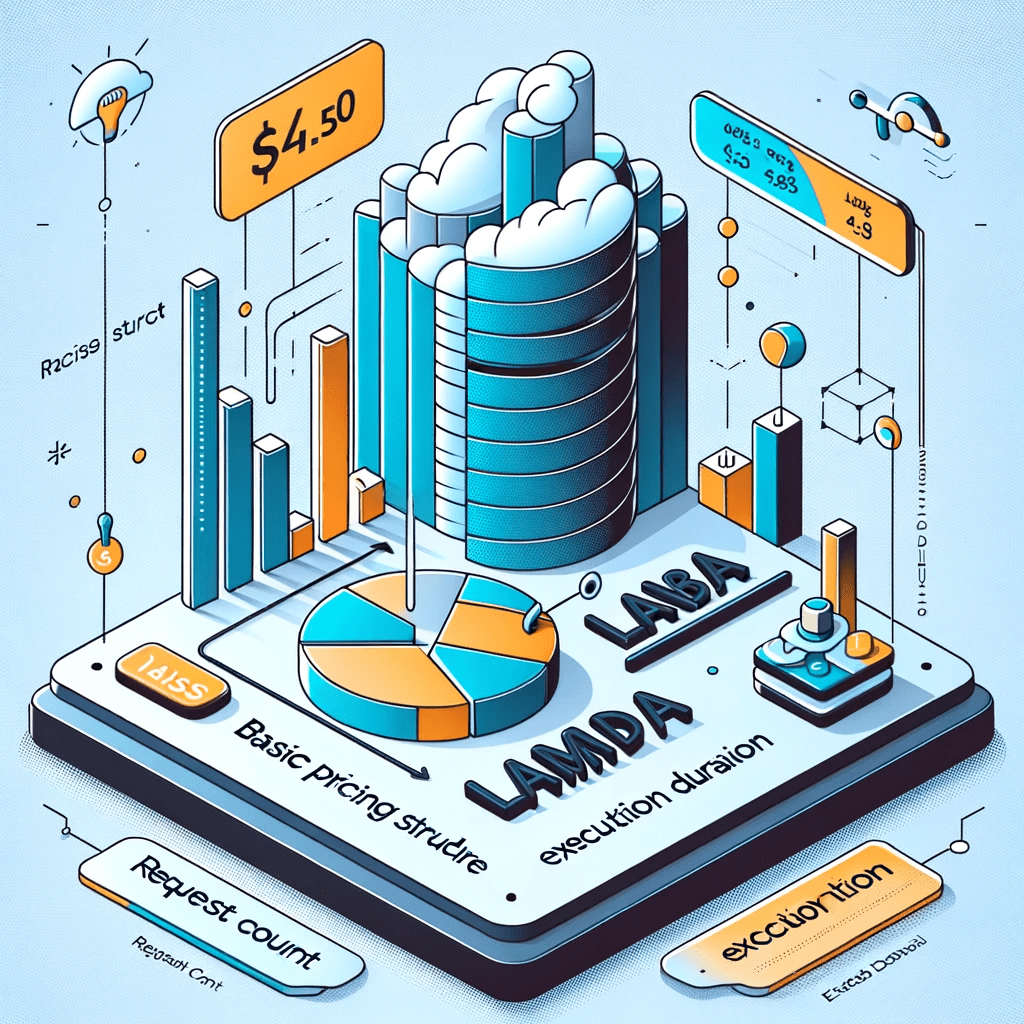Understanding AWS Lambda Pricing - A Comprehensive Breakdown


Rez Moss
@rezmos1Introduction to AWS Lambda
AWS Lambda has rapidly emerged as a cornerstone of serverless computing in the cloud ecosystem, offering a flexible, scalable, and cost-effective solution for businesses and developers. It allows users to run code in response to events, automatically managing the underlying compute resources. This revolutionary approach to cloud computing has made AWS Lambda immensely popular, particularly for those looking to optimize operational efficiency and reduce overhead.
However, understanding the pricing model of AWS Lambda is crucial for businesses to effectively budget and control their cloud expenses. Unlike traditional cloud services that often have straightforward pricing, AWS Lambda's cost structure is based on multiple factors, including the number of requests, execution time, and resource allocation. This can make it challenging for users to estimate and manage their costs effectively.
In this blog post, we delve deep into the AWS Lambda pricing structure. We will explore the basic pricing components, the additional costs associated with advanced features like AWS Lambda Docker and Lambda functions, and compare its costs with traditional cloud services. Additionally, we'll provide practical strategies for managing and optimizing AWS Lambda costs and look at real-world examples to understand how different businesses are effectively navigating this pricing model.
By the end of this guide, you'll have a comprehensive understanding of AWS Lambda pricing, enabling you to make informed decisions and optimize your cloud investments.

Basic Pricing Structure of AWS Lambda
AWS Lambda's pricing is unique and differs significantly from traditional cloud computing models. It's essential for users to understand this structure to manage costs effectively. The pricing of AWS Lambda is mainly based on two components: the number of requests and the duration of execution.
-
Request Count:
AWS Lambda charges a nominal fee for every request. A request is counted each time your function code is executed in response to an event, such as an HTTP request through Amazon API Gateway or a new file upload to Amazon S3. This pricing model is particularly beneficial for applications with irregular traffic patterns, as it aligns costs directly with usage.
-
Execution Duration:
The execution duration is calculated from the time your code begins executing until it returns or otherwise terminates, rounded up to the nearest 100ms. The cost depends on the amount of memory allocated to the function. It's important to note that you're not charged for the idle time outside of function execution.
Lambda's cost-effectiveness is most apparent in scenarios where application traffic is unpredictable. This model allows businesses to pay only for the compute time they consume, without any upfront costs or commitments. This is a stark contrast to traditional models where servers are paid for by the hour, regardless of whether they're fully utilized or not.
Understanding these two primary components of AWS Lambda pricing is the first step in optimizing your cloud expenses. In the following sections, we will further break down the costs associated with additional features like AWS Lambda Docker and Lambda functions, and offer strategies to manage these costs effectively.
Additional Costs: Understanding AWS Lambda Docker and Function Expenses
While the primary costs of AWS Lambda are based on request count and execution duration, additional features like AWS Lambda Docker and Lambda functions introduce further cost considerations.
-
AWS Lambda Docker Costs:
AWS Lambda now supports container images as a packaging format. This means you can package your Lambda function code and dependencies in a container image that can be up to 10 GB in size. However, larger container sizes can lead to increased costs, primarily due to longer cold start times and increased compute resource utilization. It's vital to optimize container sizes and manage resources efficiently to control these costs.
-
Lambda Function Costs:
Every Lambda function comes with its own set of expenses, primarily driven by the function's runtime, memory allocation, and the number of executions. Higher memory allocations can lead to higher costs, but they can also reduce execution time. Therefore, finding the right balance between memory allocation and execution speed is crucial for cost optimization.
Additionally, functions that are executed frequently or have longer runtimes will incur higher costs. It's important to monitor these functions and optimize their code to be as efficient as possible. Techniques like code refactoring, reducing external dependencies, and utilizing efficient algorithms can significantly reduce execution times and, consequently, costs.
These additional costs highlight the importance of a well-thought-out architecture and efficient coding practices in AWS Lambda. In the next section, we'll compare the costs of AWS Lambda with traditional cloud services to provide a clearer understanding of its cost-effectiveness.

Cost Comparison: AWS Lambda vs Traditional Cloud Services
Understanding the cost benefits of AWS Lambda becomes clearer when compared with traditional cloud computing services, like those based on Amazon EC2 (Elastic Compute Cloud). Here's a breakdown of how AWS Lambda costs stack up against traditional cloud services:
-
Pricing Model:
Traditional cloud services like EC2 typically charge for the compute capacity by the hour, irrespective of the actual usage. This means you pay for the entire duration the server is up and running, even if it's idle. AWS Lambda, on the other hand, follows a pay-per-use model, charging based on the number of requests and execution duration. This model can lead to significant cost savings, especially for applications with variable traffic patterns.
-
Scaling Costs:
With EC2, scaling to handle increased load involves provisioning additional instances, which also increases costs. AWS Lambda automatically scales by running more instances of the function as needed, and you only pay for the time these instances are running. This automatic scaling not only saves costs but also eliminates the need for manual scaling, which can be both time-consuming and error-prone.
-
Operational Overhead:
EC2 instances require ongoing management, such as security patching, monitoring, and scaling, which can add indirect costs in terms of labor and time. AWS Lambda abstracts away these operational burdens, as it manages the infrastructure, including maintenance and scaling. This reduction in operational overhead can translate to significant cost savings, especially for smaller teams or businesses with limited resources.
-
Performance Efficiency:
Lambda's ability to allocate resources efficiently based on demand ensures that you're not overpaying for underutilized resources. In contrast, with EC2, unless meticulously managed, there's a risk of over-provisioning (leading to higher costs) or under-provisioning (leading to poor performance).
Despite these advantages, AWS Lambda might not always be the most cost-effective option for every scenario. Long-running applications with consistent traffic patterns might be more economical on traditional services like EC2. Therefore, it's crucial to assess your specific application requirements and usage patterns before deciding.
In the next section, we'll discuss various strategies to manage and optimize AWS Lambda costs effectively.

Cost Management Strategies
Effectively managing and optimizing AWS Lambda costs is crucial for maximizing the cost-efficiency of your cloud infrastructure. Here are several strategies that can help in reducing your AWS Lambda expenses:
-
Optimize Function Execution Time:
The longer your Lambda function runs, the more you pay. Therefore, optimizing the execution time is key. This can be achieved by refining your code, reducing the complexity, and removing unnecessary dependencies. Also, choosing the right runtime and using asynchronous processing when possible can significantly reduce execution time.
-
Adjust Memory Allocation:
AWS Lambda pricing is partly based on the amount of memory allocated to your function. Often, the default memory allocation may be more than what's required. By fine-tuning the memory settings, you can ensure that you're not overpaying for unused memory while maintaining optimal performance.
-
Use Efficient Triggers:
Be strategic about the events that trigger your Lambda functions. Minimizing unnecessary invocations can lead to direct cost savings. For instance, setting up precise trigger conditions in Amazon S3 or DynamoDB can prevent Lambda functions from running unnecessarily.
-
Utilize AWS Free Tier:
AWS offers a generous free tier for Lambda, which includes 1 million free requests per month and 400,000 GB-seconds of compute time per month. Especially for small-scale applications or during development and testing, staying within these limits can effectively make your Lambda usage free.
-
Monitor and Analyze with AWS Tools:
Regular monitoring and analysis of your Lambda functions using AWS CloudWatch and AWS Cost Explorer can help identify cost-saving opportunities. These tools provide insights into function invocations, execution times, and associated costs, allowing for informed decision-making.
-
Implement Architectural Best Practices:
Adopting architectural best practices such as decomposing large functions into smaller, more manageable ones, and reusing connections (e.g., database connections) can improve performance and reduce costs.
By implementing these strategies, you can ensure that you are using AWS Lambda in the most cost-efficient way possible. It's all about finding the right balance between performance and cost.
Real-world Case Studies
Examining real-world case studies can provide valuable insights into how different businesses manage their AWS Lambda costs effectively. These examples highlight best practices and lessons learned in optimizing Lambda expenses:
-
E-Commerce Platform Optimization:
An online retail company used AWS Lambda to handle its fluctuating website traffic, especially during peak shopping seasons. By leveraging Lambda's automatic scaling and pay-per-use model, they managed to reduce costs significantly compared to a traditional EC2 setup. The key takeaway was the alignment of costs with actual usage, allowing for efficient resource utilization during traffic spikes.
-
Media Company's Data Processing:
A media company utilized AWS Lambda for real-time data processing. Initially, they faced high costs due to inefficient code and over-provisioned memory settings. By optimizing their Lambda functions for faster execution and adjusting memory allocation, they achieved a 40% reduction in costs. This case study underscores the importance of continual monitoring and optimization of function settings.
-
Startup Leveraging Free Tier:
A tech startup in its initial phase effectively utilized AWS Lambda's free tier to run their application with minimal costs. By staying within the free tier limits and optimizing their code, they managed to avoid costs during their critical development phase. This example demonstrates the strategic use of AWS's free tier for startups and small businesses.
-
Financial Services Firm's Cost Management:
A financial services firm implemented detailed monitoring and analysis using AWS CloudWatch and AWS Cost Explorer. This approach helped them identify inefficient functions and reduce unnecessary invocations, leading to a 30% cost reduction in their AWS Lambda usage. The firm's experience highlights the effectiveness of AWS's built-in tools in managing Lambda costs.
These case studies illustrate various strategies and approaches businesses have taken to optimize AWS Lambda costs. From leveraging the pay-per-use model and free tier to continuous monitoring and function optimization, these examples provide practical insights that can be applied to any business using AWS Lambda.
Future of AWS Lambda Pricing
As we look ahead, the pricing model for AWS Lambda is likely to evolve in response to technological advancements, market trends, and user feedback. Staying informed about these changes is crucial for businesses to continue optimizing their AWS costs effectively. Here are some potential developments and their implications for AWS Lambda pricing:
-
Increased Emphasis on Performance Optimization:
AWS may introduce more sophisticated pricing tiers based on performance optimization. This could mean lower costs for highly optimized functions, incentivizing users to fine-tune their Lambda functions for efficiency and cost-effectiveness.
-
More Flexible Pricing Models:
In response to diverse user needs, AWS might offer more flexible pricing options. This could include tailored packages for different types of workloads, such as high-frequency, short-duration functions or long-running, resource-intensive tasks.
-
Integration with Emerging Technologies:
As AWS integrates Lambda with newer technologies like machine learning and IoT, we might see specialized pricing models that cater to the unique demands of these applications. This could include pricing based on the complexity and computational requirements of machine learning models or IoT device interactions.
-
Enhanced Cost Management Tools:
AWS is likely to continue enhancing its cost management tools, providing users with more granular insights and predictive analytics to forecast and manage their Lambda expenses better. This could involve advanced AI-driven tools to optimize costs automatically.
-
Community Feedback and Adjustments:
AWS has a history of adjusting its pricing and services based on user feedback. As the community of Lambda users grows and their needs evolve, AWS will likely make adjustments to its pricing model to stay competitive and meet user demands.
Keeping abreast of these developments will be key for businesses looking to leverage AWS Lambda efficiently. By staying informed and adaptable, organizations can continue to enjoy the benefits of AWS Lambda while effectively managing their cloud expenditures.
Conclusion
In conclusion, understanding AWS Lambda's pricing structure is crucial for businesses looking to leverage this powerful serverless computing service effectively. By breaking down the costs associated with requests, execution duration, and additional features like AWS Lambda Docker and Lambda functions, users can gain a clear picture of their potential expenses. Comparing these costs with traditional cloud services highlights the cost-effectiveness of AWS Lambda for certain applications, particularly those with variable traffic. Moreover, implementing cost management strategies such as optimizing function execution time, adjusting memory allocation, and using efficient triggers can lead to significant savings. Real-world case studies offer practical insights into how various businesses have successfully managed their Lambda costs. Looking to the future, staying informed about AWS Lambda's evolving pricing models and integrating new tools and technologies will be key to maximizing cost-efficiency and staying competitive in the ever-changing landscape of cloud computing.